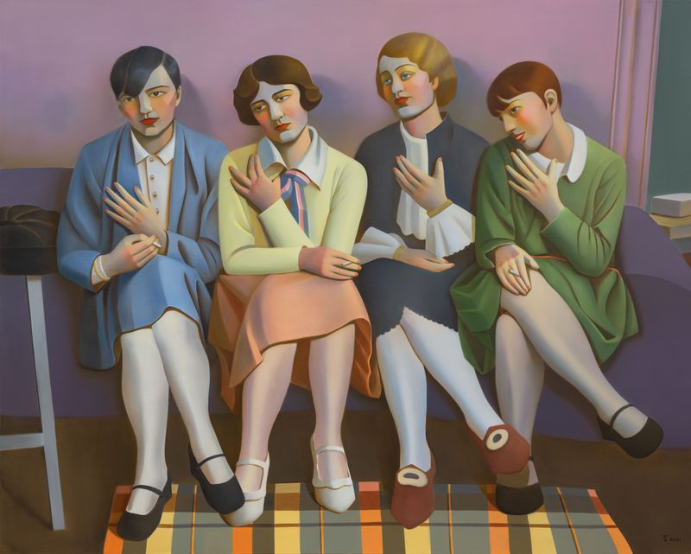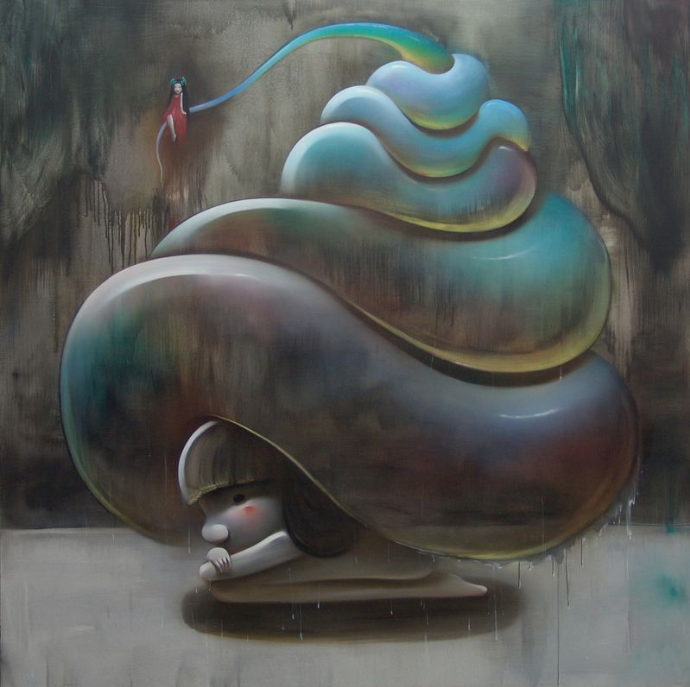The artist’s Paris gallery debut “Bauhaus Gals—Theatre” is on view at Perrotin.
“I envision the entire exhibition as one art piece, transforming the space into a theatrical realm,” Chen Ke said during a video call from Beijing studio late this summer. Chen, who is known for her meticulously crafted paintings, was in the process of conceptualizing her debut Paris exhibition “Bauhaus Gal—Theatre” at Perrotin, which opened earlier this month.
In its final form, Chen’s intricate designs have come together in an exhibition that brings together painting and architectural photography within a playful theatrical scenography that draws from the legacy of the Bauhaus, the famed early 20th-century German applied art school. At the center of Perrotin’s Paris gallery, a spiral metal sculpture hangs, its reflective aluminum surfaces casting dazzling colors throughout the space. These radiant reflections, both enchanting and disorienting, deter visitors from approaching too closely, who might be wary of the sharp edge of the work. It’s a seamless negotiation of visual to tactile sensations that hint the Bauhaus’s material experiments. Another work, a bright golden screen, reminiscent of an old folding screen, is lit with colorful lights, luring visitors in and suggesting another world exists behind it. Once stepping into the gallery space, a striking sequence of portraits created a dramatic introduction.

Chen Ke, Bauhaus Gal No.12, 2021, source: PERROTIN
The core of the exhibition is a luminous new group of portraits of the Bauhaus’s women students, a continuation of the artist’s ongoing “Bauhaus Gal” series. These latest works exude more drama than before, however. This shift in artmaking happened “unconsciously”, according to the artist. Some of these portraits picture women bathed in stark flashlight beams, creating intensified facial contrasts and evoking a nostalgic, sci-fi utopian ambiance. Yet, the artist ultimately rejected her first title for the exhibition— “Utopia”— believing it “didn’t resonate with the genuine Bauhaus narrative, especially concerning these women artists.”

Chen Ke, Bauhaus Gal No.11, 2021 (Standard poster),
source: PERROTIN STORE PARIS
“I recognize that this artistic shift is unusual and that the choices of characters and colors might be tied to the experiences of the last three years,” said Chen, alluding to her own psychological and emotional shifts. Her resident city, Beijing, went through several sudden lockdowns and periods of abrupt quarantines in 2023, impacting artists without a doubt. “The past few years have been more dramatic for me, and sometimes you’re not sure if you’re in reality or a dream,” Chen described of her dazing experience.

Chen Ke, The meaning of traveling, 2008, source: PERROTIN

Chen Ke, Yesterday’s me, Tomorrow’s you, 2012, source: PERROTIN
In the theatrical setting she has crafted in the gallery, the women in her portraits often seem to be in a self-imposed disguise. Beyond the paintings, the space is also filled with architectural and abstract works, interspersed like stage sets. Chen Ke resists being pigeonholed as merely a portrait painter, and she also values architecture’s significant role in Bauhaus history.
Conceived around 2020, the “Bauhaus Gal” series was inspired when Chen accidentally came across a Bauhaus photo book. Flipping through its pages, she felt as though she was journeying through a time tunnel. Chen found herself face-to-face with the Bauhaus women from a century prior. These women, often overshadowed by history’s narrative, resonated with Chen’s own experiences as a woman artist. Drawing from empathy and reimagination, she breathed life into the black-and-white photographs, infusing them with vivid hues, and resurrecting the tales and visages of the Bauhaus women for contemporary audiences.

Chen Ke, The snail’s house, 2006, source: PERROTIN
While this exhibition marks Chen’s first solo show in Paris, her star has been rising for some time. She first came to attention in 2007, through a partnership between the Beijing-based Star Gallery and Italy’s Marella Gallery. By 2016, Chen was represented by Perrotin and was showcased in a solo exhibition “Dream·Dew” at the bluechip’s Hong Kong space that same year. More recently. Chen has ascended as one of the most popular “born after the 70s generation” of Chinese artists who are widely sought after amongst collectors (Chen was born in 1978). In 2021, Perrotin Shanghai debuted “Bauhaus Gals” and has since solidified this series as the artist’s most acclaimed and notable ones.

Chen Ke, Matador (2006).
Chen’s market success, beyond her “Bauhaus Gals” series, has garnered considerable attention and discussion. In 2023, her large-scale painting, Matador (2006), fetched an impressive RMB 9,085,000 (approximately USD $1,252,900) at Yongle Auction, tripling its high estimate and setting a new personal record for the artist. In. 2016, this same painting auctioned at Poly Auction Macau for approximately USD $258,395.
In the latest 2023 Hurun China Art List, Chen ranked in the 37th spot, making her the top-ranking female artist included (Notably, out of the 100 artists on the list, only eight are women.). Her artworks amassed sales totaling RMB 15,670,000 (approximately USD $2,150,000) in this past year.
During our conversation, Chen Ke spoke about the impact entering the “million dollar club” has had on her mindset, noting that “market numbers have always been part of my career.” She admitted feeling emotional highs and lows due to market pressures in the past years. With experience, she’s learned to distance herself from such external factors, “[auction prices] actually reflect the outcomes of another world.” Downturns didn’t hinder her artistic spirit; in fact, they catalyzed pivotal shifts in her creativity.
After she earned her MFA from the Oil Painting Department at the Sichuan Fine Arts Institute in 2005, Chen relocated to Beijing, joining the so-called “Beijing drift”—a term that refers to the influx of young individuals moving to Beijing from other parts of China in search of better job opportunities and a brighter future, often facing challenges like high living costs and social alienation. During her graduate school studies, Chen had appreciated her sense of creative freedom, even exploring photography, but it was a study visit to Europe, where she encountered early Renaissance paintings, that most profoundly impacted her. This experience invigorated her passion for painting, spurring experimentation in the medium.

Chen Ke, Bauhaus Gal No.33 (2023). Photograph by Hao Yang.
Courtesy of the artist and Perrotin.
In the early 2000s, Chen Ke’s paintings prominently featured cartoon-like melancholic little girls, earning her a place among China’s “Cartoon Generation.” This group, primarily artists born in the late 70s and 80s, grew up during China’s rapid modernization and was influenced by consumerism, video games, and animation. Their work often depicts the challenges and aspirations of a changing society. For Chen, the little girls in her paintings are also personal reflections. While many artists from her generation explore these themes, Chen’s approach is uniquely feminine and introspective. Works like the record-breaking Matador are typical during this “Cartoon” period, with a central figure, a little girl with horns emerging from her head, resting atop a massive white yak, appearing to be in a profound slumber.
“I spent my childhood in Sichuan province, a region in China where women typically hold stronger roles in family life, which perhaps subtly influenced me,” said Chen. During her college years, she dove into classic women’s studies books like The Second Sex and learned about Western women artists such as Nan Goldin and Cindy Sherman. “I realized that women could be both deeply sensitive and immensely creative,” Chen reflected. This admiration kindled her artistic aspirations, “being like them seemed so cool. It’s largely why I perused to be an artist.”
In 2012, a significant shift occurred in Chen’s career. During a challenging period (also the “low years” according to her) in her career, Chen Ke faced a creative block. Around the same time, she became a mother. While pregnant, she came across a photobook of Frida Kahlo. The vintage photos reminded Chen of her fondness for photography from her student days. She was moved to create a series of portraits inspired by Kahlo, producing 20 to 30 in succession. This practice of drawing and painting from old photos persisted in her later series. This transition allowed Chen Ke to move beyond personal introspection and connect with historical female figures, allowing her to engage in a dialogue with historical women across time and space.

Chen Ke, Bauhaus Gal No.26 (2023). Photograph by Hao Yang.
Courtesy of the artist and Perrotin.
Chen also sought inspiration from various iconic women, including Marilyn Monroe and overlooked American Modernist Helen Torr, who was the central figure of her 2020 exhibit, “The Anonymous Woman Artist.”
In the 2016 Perrotin Hong Kong exhibition featuring Marilyn Monroe, a piece titled 1955 – NEW YORK – 29 YEARS OLD (2016) was showcased. Chen Ke depicted a fictional scene where, on a morning in New York, Monroe stood on a balcony bathed in the sunrise. She appeared relaxed, smoking a cigarette, exuding confidence. At the top of the painting, Chen wrote the Chinese translation of a line from Monroe’s autobiography: “I used to think as I looked out on the Hollywood night, ‘There must be thousands of girls sitting alone like me dreaming of being a movie star.’ But I’m not going to worry about them. I’m dreaming the hardest.’”
Transitioning into motherhood, Chen once again reflected deeply on her identity as a woman, “After being a mother, the physiology would make me encounter many series of problems related to gender in reality,” she said. Around this time, Chen’s sense of femininity in her work became subjectively stronger and more unavoidable. Being both an artist and a mother brings unique challenges for Chen. Like many other female artists, she often confronts questions about motherhood. Balancing her roles is an internal battle filled with conflict and guilt, often wishing to devote more time to her child, but unable to. Motherhood has been a profound journey for her. As she described, “From floating aimlessly in darkness, I was suddenly grounded.”
Life’s realities sharpened her vision, making her more attentive to the world’s details and changing her perspectives on many issues. Consequently, the art studio and the act of painting serve as sanctuaries, places of escape for this artist, “Art seems like another line parallel to life, or they reflect each other, like mirrors.”
Written by Cathy Fan
Source: Artnet







